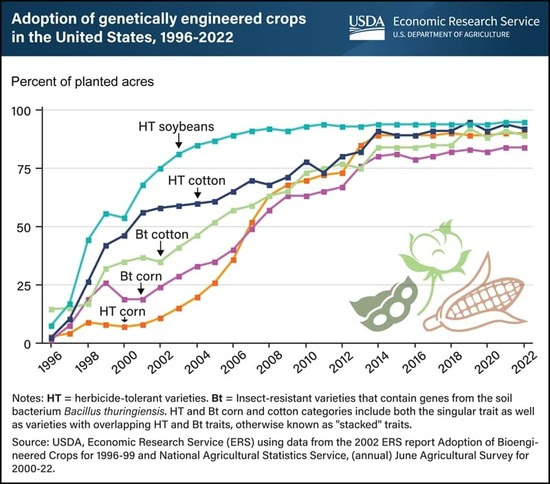|
News Bits
U.S. corn and soybean harvest activity continued to move forward over the past week.
Rain did delay activity in parts of the Midwest and Plains and while that's helped replenish soil moisture and provide a slight boost to river levels, more will be needed in many areas.
The USDA says 76% of U.S. corn is harvested, compared to the five-year average of 64%, and 88% of soybeans are harvested, compared to 78% on average.
87% of winter wheat is planted, compared to the usual rate of 85%, and 62% has emerged, compared to 66% on average, with 28% of the crop in good to excellent shape, compared to last year's first rating of 45%.
55% of cotton is harvested, compared to 47% normally in late October, and 96% of bolls have opened, compared to 94% typically this time of year.
97% of rice is harvested, matching the five-year average.
23% of U.S. pastures and rangelands are called good to excellent, up 1% on the week.
Russia is returning to a grain export agreement with Ukraine after a four-day suspension.
Greg McBride with Allendale says this means Ukraine can resume exporting grain safely through the Black Sea Region.
"What they are doing is moving (grain) from Ukraine, or even Russia, to Turkey," he said. "They are having it inspected, and then moving it onto its final destination."
He tells Brownfield the reversal caused wheat futures to drop sharply overnight.
"When this kind of thing happens, you see the concern for food security," McBride said. "That's where you see the markets like rice and wheat to go through the roof. Now, they've started to back off a little bit. Same thing with the oats, and now you just undid everything that you did earlier this week."
The deal expires November 19th and all countries involved will have to agree to an extension.
A fungus that causes "vomitoxin" has been found in some U.S. corn harvested this fall, causing headaches for growers and livestock producers and forcing ethanol plants and grain elevators to scrutinize grain deliveries.
The situation is another hit to global grain supplies that have sunk to the lowest in a decade since Russia invaded corn and wheat producer Ukraine. Drought has also slammed U.S. and European crops.
Feed made from grain contaminated with concentrated levels of the plant toxin can sicken livestock and lead to low weight gain, particularly among hogs, and grain buyers can reject cargoes or fine farmers for shipments that contain it.
Early signs of the toxin are emerging in Ohio, according to a weekly report from the U.S. Department of Agriculture. Grain buyers in eastern Indiana are also starting to more rigorously test corn deliveries for vomitoxin, according to farmers and elevator sources.
The toxin is also a problem for ethanol producers who sell a byproduct called distillers dried grains (DDGS) for animal feed. In the process of making ethanol, vomitoxin becomes more concentrated in DDGS, said Pierce Anderson Paul, a professor and epidemiologist with Ohio State University's department of plant pathology.
Deere (NYSE:DE) is investing $29.8 million to begin making harvesters in the United States instead of China. The agricultural machinery giant is expanding its factory in Thibodaux, Louisiana, and adding 70 jobs, the state's development agency announced.
Factoids
Since August 2021 China has built 43 new coal-fired electrical generating plants with many more pending future construction. China accounted for over half the new coal-fired plants built worldwide in the last three years.
The Chinese bond market for property development has cratered. The dollar bond rates for Chinese property and real estate development have plummeted to new lows of as little as ten cents on the dollar reflecting a lack of confidence in the sector. Bond futures for Chinese real estate development is currently six cents on the dollar for bonds due in 2028 representing an annual decline of 91%.
Germany was slated to mothball its last four remaining nuclear powered electric generating plants by the end of 2022. All four have been given a new, but brief, lease on life by the new conservative government coalition. All four will be refurbished sufficiently to see their service extended to April 2023. Refurbishment will not include refueling. Northern Europe is forecast to be headed for a harsh winter with not enough power to go around to maintain public safety and warmth.
With the Mississippi River closed to barge traffic due to drought conditions movement of essential goods must find other, more expensive, routes. Transportation of grain and fertilizer are heavily impacted. The Rhine River, one of the prime mid-European arteries, has been similarly closed to barge traffic since late spring 2022 disrupting commerce and supply lines as much, or more, than the closing of the Mississippi.
The United Nations most recent climate report claims carbon dioxide reductions must come from the global food system which they say contributes a third of greenhouse gases. According to the report seven gigatons in carbon dioxide reductions, equal to all present-day natural gas production, will have to come from people eating less meat.
European fertilizer manufacturers are beginning to restart production with the recent fall in natural gas prices. Most other energy-intensive industries in Europe are taking a more wait-and-see attitude but fertilizer makers don't think they can wait with spring demand right around the corner. Norway based Yara International, one of the world's largest fertilizer companies, is currently operating at 65% of its available ammonia capacity almost doubling what it was tapping earlier this year. As high as fertilizer prices are here they are close to double in most of Europe.
|
 USDA REPORTS MORE THAN 75% OF SOYBEAN, COTTON AND CORN ACRES ARE GENETICALLY ENGINEERED
USDA REPORTS MORE THAN 75% OF SOYBEAN, COTTON AND CORN ACRES ARE GENETICALLY ENGINEERED USDA REPORTS MORE THAN 75% OF SOYBEAN, COTTON AND CORN ACRES ARE GENETICALLY ENGINEERED
USDA REPORTS MORE THAN 75% OF SOYBEAN, COTTON AND CORN ACRES ARE GENETICALLY ENGINEERED